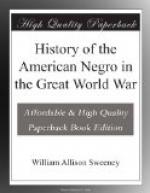The heroic exploit of Professor Cook, the “Y” secretary, which secured him a recommendation for the Distinguished Service Cross, is mentioned elsewhere. It was only equalled by the valiant performance of A.T. Banks of Dayton, Ohio, a Negro “Y” secretary who went over the top with the 368th Infantry. Secretary Banks, during the action, tarried to give aid to a wounded soldier. The two were forced to remain all night in a shell hole. During the hours before darkness and early the following morning they were targets for a German sniper. The secretary succeeded in getting the wounded man back to the lines, where he then proceeded to organize a party to go after the sniper. They not only silenced him, but rendered him unfit for any further action on earth. Mr. Banks returned to America with the sniper’s rifle as a souvenir. His work was additionally courageous when it is considered that he was a non-combatant and not supposed to engage in hostilities. Had he been taken by the Germans he would not have been accorded the treatment of a prisoner of war, but undoubtedly would have been put to death.
Were the records sufficiently complete at the present time to divulge them, scores of examples of valorous conduct on the part of the “Y” workers, Red Cross and other non-combatants who ministered to Negro soldiers could be recounted. The work of all was of a noble character. It was accompanied by a heroic spirit and in many cases by great personal bravery and sacrifice.
CHAPTER XXVII.
NEGRO IN ARMY PERSONNEL
His mechanical ability required—skilled at special trades—victory depends upon technical workers—vast range of occupations—negro makes good showing—percentages of white and black—figures for general service.
In 1917 and 1918 our cause demanded speed. Every day that could be saved from the period of training meant a day gained in putting troops at the front.
Half of the men in the Army must be skilled at special trades in order to perform their military duties. To form the units quickly and at the same time supply them with the technical ability required, the Army had to avail itself of the trade knowledge and experience which the recruit brought with him from civil life. To discover this talent and assign it to those organizations where it was needed was the task of the Army Personnel organization.
The army could hardly have turned the tide of victory if it had been forced to train from the beginning any large proportion of the technical workers it needed. Every combat division required 64 mechanical draughtsmen, 63 electricians, 142 linemen, 10 cable splicers, 156 radio operators, 29 switchboard operators, 167 telegraphers, 360 telephone repairmen, 52 leather and canvas workers, 78 surveyors, 40 transitmen, 62 topographers, 132 auto mechanics, 128 machinists, 167 utility mechanics, 67 blacksmiths, 151 carpenters, 691 chauffeurs (auto and truck), 128 tractor operators and 122 truckmasters.




